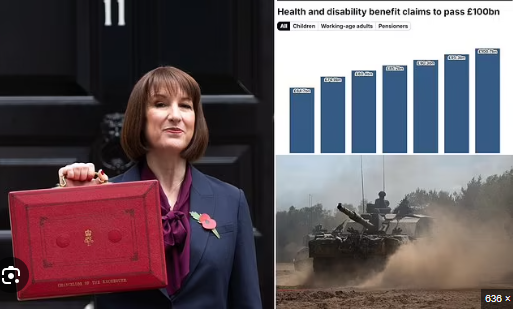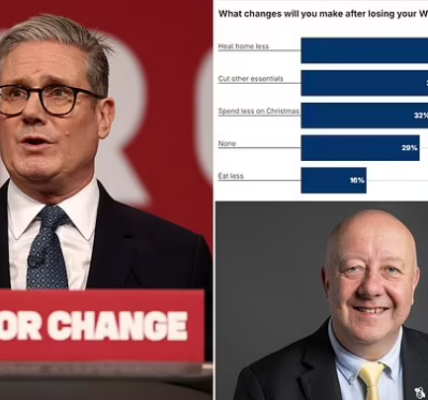Health and disability benefits costs in sicknote Britain will pass £100BILLION a year by the end of the decade – more than Britain spends on defence – experts warn after tax-raid Budget_Nhy
Health and disability benefits in sicknote Britain will cost more than £100billion a year by the end of the decade, proportionally more than the UK spends on defence.
In its Budget analysis the Office for Budget Responsibility (OBR) estimated that the cost of long-term sickness handouts would rise from £64.7billion in the 2023-24 financial year to £100.7billion in 2029-30.
And it warned that this estimate was an ‘uncertain judgement’ because of complex factors involved – meaning it could end up being even higher.
Currently 9.4million Britons are neither in a job or looking for one, equating to more than a fifth of the working-age population. It includes a near-record figure for those signed off with long-term sickness.
The 2029-20 figure of £100.7bn equates to 3 per cent of GDP, the OBR noted. This is higher than the 2.5 per cent of GDP that the government has pledged to spend on the military – though without setting out a timeframe for achieving it. Defence spending is currently 2.33per cent of GDP.
The OBR report also noted that the ‘participation rate’, the proportion of the population either in work or seeking it, will fall to 62.5 per cent by 2029 ‘driven by rising health-related inactivity, the overall ageing of the population, and the rise in employer NICs announced in this Budget’. This is down from a peak of 64.25 per cent in 2020.

In its Budget analysis the Office for Budget Responsibility (OBR) estimated that the cost of sickness handouts would rise from £64.7billion in the 2023-24 financial year to £100.7billion in 2029-30.

The 2029-20 figure of £100.7bn equates to 3 per cent of GDP, it noted. This is higher than the 2.5 per cent of GDP that the government has pledged to spend on the military, without setting out a timeframe for achieving it.
The OBR noted: ‘Inactivity due to long-term sickness remains high at around 2.8 million, accounting for a third of total inactivity, although the latest data suggest it may have reached its peak. This is consistent with incapacity benefits caseloads, which rose 36 per cent between 2019-20 and 2023-24, from 2.3 to 3.1 million…
‘The increase in employer NICs announced in this Budget reduces the participation rate by 0.1 per cent from 2025-26 onwards.’
Worklessness due to long-term sickness has soared six-fold in parts of Britain since pre-Covid, analysis suggests.
Currently 2.8million people are off work ill, up by around 700,000 before the pandemic rocked the country.
Spiralling rates of mental ill health has driven the ‘economic inactivity crisis‘, which Labour has promised to tackle as part of its plans to give the economy a boost and save taxpayers billions on welfare hand-outs.
Young people are now just as likely to be out of work because of long-term illness as people in their 40s, the Resolution Foundation suggested earlier this year.
In the Budget yesterday Chancellor Rachel Reeves pledged to make savings via ‘fundamental reforms to the health and disability benefits system’.
It comes amid a major inactivity crisis the Labour government inherited from the Tories, with around 2.75million people claiming incapacity benefit. Four out of five claimants have not worked in the past two years.
On Monday Prime Minister Sir Keir Starmer unveiled a £240 million funding boost in the Budget for local services to ‘get Britain working’.
Labour had previously promised reforms to help the ‘lockdown generation’ get back into employment, and ministers are expected to publish a Get Britain Working White Paper this autumn.
Those reforms aim to marry an approach of high expectation and high support, with the expectation that those who can work should do so but that they should also be properly supported with real opportunities to get a decent job.
When Liz Kendall took over as Work and Pensions Secretary after the July election, she said Labour’s goal to reach an 80 per cent employment rate would mean getting two million more people back into work.
She also said powers and resources would be transferred to mayors and local areas to lead work, health and skills plans for the economically inactive.




